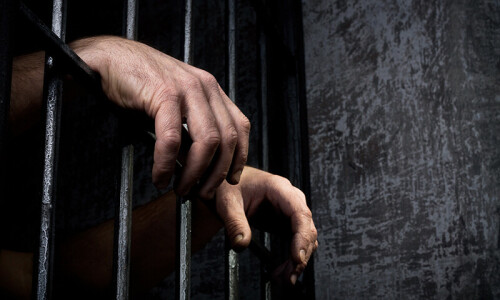KARACHI: As the senior officers of the Sindh Police in their crisp ceremonial uniforms briskly walked up to take their seats in the auditorium, the friction of the gleaming medals on their chests brought out a jingling bells-like sound.
The 176th Scinde (Sindh) Police Raising Day ceremony held at the Police Headquarters here on Wednesday included the opening of the Sindh Police Museum.
Deputy Inspector General of Police (DIG) Karachi South Sharjeel Kharal in his opening remarks said that the Police Raising Day was being commemorated for the first time in 176 years. Sharing some history, he said that Sindh used to be known as ‘Scinde’ back in 1843, when soon after the annexation of this region Sir Charles Napier ordered the raising of the Scinde Police. “It was the first modern police of the subcontinent commanded by its own officers. Innovation was its hallmark. It became the first police force to employ foot trackers for detection of criminals in India. Its detection rate was one of the highest in the Bombay Presidency till late 19th century. And after the Bengal Police it was the second police force to operate a riverine section to combat rampant cattle lifting,” he said.
DIG Kharal also said that another salient feature of the Sindh Police was their mobility. “Till the 1940s, it had the largest mounted police section in India, which gave it an edge on other police forces in the region in combating heinous crime. Today, it comprises about 150,000 men and officers. Having evolved over the years into a community oriented force, community policing is now at the heart of policing in Sindh,” he said before paying rich tributes to the officers who have gone beyond the call of duty by laying down their lives for their country.
Sindh Police Museum opens
Former IGP Saud Ahmed Mirza, the main person behind the development of the Sindh Police Museum, spoke about the first head of ‘Kurrachee’ (Karachi) Police Lt Edward Charles Marston, who served the Scinde Police from 1843 to 1872 and how he raised the force. He said that [then] Governor of Sindh Sir Charles John Napier had a galaxy of young and dashing officers such as Young Husband, Preedy, John Jacobs, etc. “But he settled for Captain Brown to head the Sindh Police after the annexation of Sindh and Lt Edward Charles Marston to head the Karachi Police,” he said, adding that when Marston arrived in India he was only a 21-year-old soldier and he became police chief at age 24.
He said that Napier’s police system was based on two principles — first, the police were to be completely separate from the military and secondly, they must be an independent body to assist the collectors in discharging their responsibilities for law and order but under their own officers. “From 1943 to 1948, Scinde Police comprised three districts, namely Kurrachee, Hyderabad and Shikarpoor. Its total strength was 2,400,” he said, adding that this police force was divided into three branches — mounted police on horseback, rural police and city police.
“The major augmentation of Sindh Police took place after the 1857 rebellion following which its strength increased from 3,157 to 4,013 men,” he said. About Marston’s career, he concluded that after 29 years of service with the police, he reverted to the army from where he eventually retired in 1891.
Sindh IGP Dr Syed Kaleem Imam appreciated former IGP Saud Mirza’s work in digging up all this history and setting up the Sindh Police Museum. He also spoke highly of and thanked all the IGPs and other policemen who assisted Mr Mirza and contributed to the work. “Perhaps this museum can be a master police museum for Sindh with Saud and his team travelling to India and England to maybe try and acquire more historic material for it,” he said.
Former IGP Syed Kamal Shah, the chief guest on the occasion, said that he spent 20 years with the Khyber Pakhtunkhwa Police and three and a half years with the Sindh Police. “But I consider Sindh Police absolutely at par with KP Police,” he said, adding that Sindh Police’s devotion and commitment to their job was their biggest quality.
About the Sindh Police Museum, about which he appreciated the depth of research and meticulous work carried out by former IGP Mirza and his team, he also had a suggestion. “Since the records and pictures mostly stop at 1950, I would suggest to carry on with the archiving work till 2019 as then it will be easier to keep on updating the records.”
Published in Dawn, May 2nd, 2019

















































